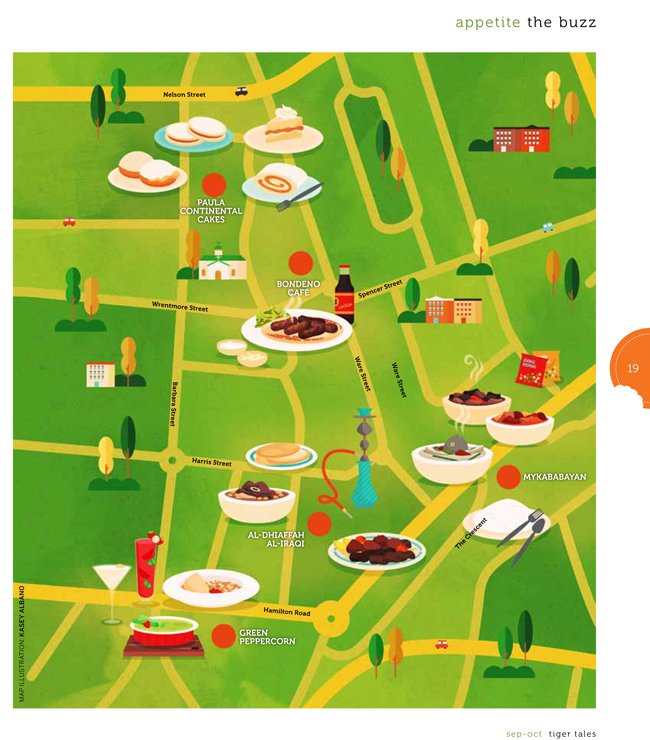The Three R’s of blogger engagement
Noodlies, Sydney food blog’s top tips.
Pesky things these bloggers: food, mommy/parent, tech, travel, fashion and more. Out there on the bloggersphere in their thousands and growing.
Like it or not, bloggers are no longer on the fringes, brands are taking bloggers more seriously, putting the pressure on PR agencies.
Greg Tan, digital strategist at Social@Ogilvy in Sydney has worked in this space for over four years. He says up to “a couple years ago, we were trying to convince clients to do more blogger engagement. These days, they’re coming to us asking for it”.
Candice Deville has been blogging at her wildly popular fashion blog, Super Kawaii Mama for six years and has noticed “a massive increase in the attention it receives from brands and PR’s. Initially when I would pitch companies (before they we doing that themselves), it was an uphill battle to even explain what it is a blog does”.
Why the sudden demand for online reviews? Think about it: where do you go to when researching restaurants, electronic gadget, travel, hotels, etc – the first stop is almost always the internet. When I googled “Quay restaurant Sydney”, arguably Australia’s most awarded restaurant, the first two pages of results only one was from traditional media – Gourmet Traveller. The other 19 results were from the Quay’s corporate website, online reviews sites like Urbanspoon, Tripadvisor and of course the food blogs.
Even, veteran food critic John Newton concedes in his last book Grazing, the sheer volume of posts and ratings on the blogosphere has diminished the voice of the newspaper food reviewer: “… on the street, the influence of professional reviewers is on the wane, if not on the way out.”
As a result of the new-found demand, bloggers are being inundated. My blog, noodlies is three years old. In the beginning no one emailed, these days I get at least 200 emails each week – media releases, invites, sponsored post requests, advertising requests, media requests and offers to join blogger networks.
The good PR approaches are great, the bad ones are memorably woeful, in fact, they damage the PR and their client’s brands. For the vast majority, blogging is a (very time-consuming) labour of love, in between a full time job. We love what we do, but we don’t have time for half-arsed pitches.
When you piss off bloggers, you risk them venting to their networks and on social media. Instead of venting, I prefer to take a more positive, pro-active approach. I’ve put together a few suggestions on effective ways to work with bloggers. These tips are based on my experience and feedback from PR professionals and other bloggers. This is no be-all-and-end-all, though most of it is common sense, and I’m confident if you follow these tips your pitches will be more effective. Let’s call them noodlies’ Top Tips for Engaging with Bloggers: The Three R’s.
- Research
- Reach Out
- Review
1. Research
Read a blog’s ‘about’ page before making contact
It’s daunting because there are just so many blogs out there, but if you don’t put in time to research up-front then you’re building on a rocky foundation. If you don’t have an existing list, do some online research, for example, if you’re researching food blogs, generate a prospect list from:
- Urbanspoon and other review sites.
- Googling relevant searches, if you’re client is pasta sauce you might search “recipe food blogs”, “Italian food blogs” etc. If your client is location based, narrow your search – “Sydney food blog”.
- Many food blogs often contain lists/links to other food blogs.
- Talking to other PR’s, it’s a relatively untapped area and many are often very willing to share their experiences.
Compile a list of around 20 prospect blogs, depending on the category for further research. The only way to understand these blogs is by reading them. Zina’s blog, Tasted by Two has been inactive for over a year (she’s moved to Singapore) but she’s still getting invites to Sydney events. Read the blog and you’ll notice the last post was 22 February, 2012. A blog’s “About” page and the most recent post are the most obvious starting points. Look for:
- Activity: in the online world, no one returns if the content is static. If a blog hasn’t been active for over a month, it would be hard to put it forward to a client. Irregular postings maybe an issue if your project is time sensitive.
- Brand alignment/conflict: Tan says “sharing similar values or interests is essential”, but you won’t know this unless you take time to read the blogs. I’ve written about the poor ratings of the recent MasterChef The Professionals series and have been a vocal fan of the current My Kitchen Rules series, yet I’ve been approached by a brand associated with the current Masterchef series.
- Receptiveness to PR approaches: some food bloggers for example will not accept invites to review restaurants. My blog has an ethics page which spells out my values and how I engage with PRs and brands.
- Point of difference: what makes that food blog different from over 2,000 other food blogs in Australia? Noodlies’ about page is clear, I rarely cook or eat at home, but I still get invites to cooking classes and offers to trial ingredients.
- Engagement and influence levels: beyond the level of activity is the level of audience interaction with that blog but “how the audience interacts with the content and their social media footprint, including are they active on twitter and Facebook?” says Alexandra Loftus, Account Executive at Edelman.
- Integrity: Both Loftus and Tan nominate this as a key criterion. Brands want to be associated with a blog which readers trust because of its authenticity and transparency.
2. Reach Out
When PRs reach out “mostly it’s always more a ‘win’ for them. It should be a win for them and a win for me”
When I did a quick twitter survey on what makes a good PR approach the response was overwhelming: bloggers want PRs to take them seriously, have some knowledge of their blogs and to treat them like real people.
DeVille says her gripes are “Email blasts. Being put on a list of hundreds, with no personalisation, no time taken to determine product fit and the assumption that advertorial will be provided gratis”.
Trevor Long from EFTM (Everything For The Man) says “when a blog is niche it’s great to be recognised for that. In EFTM’s case it’s great when PR talk to us about “stuff for men” which acknowledges they know what we are about”.
Here are a few tips when you reach out to bloggers:
- Lack of Personalisation: is by far the biggest pet hate of bloggers. I’ve had emails which begins with “Dear , ” and when the mail-merge goes wrong “Dear Julie”. Amy of Melbourne Food Snob says “I hate when they address me by the name of my blog instead of my first name”.
- Avoid badly written releases: Perth blogger, Bri of Eat Meets West says a pet hate is “badly written releases – I got one last week that I wanted to correct and send back”.
- Mutual benefit: Demonstrate in your pitch you understand their blog and show how your opportunity is of value to them or their readers. Julie, of Melbourne blog, I Dream in Chocolate says when PRs reach out “mostly it’s always more a ‘win’ for them. It should be a win for them and a win for me”.
- Flexibility: bloggers mostly have day time jobs, so day time invites won’t be very successful. Simon from Simon Food Favourites says last minute invites also makes it hard for working bloggers. Be flexible when bloggers suggest alternative content ideas, rather than seeing it as more work, evaluate their offers based on potential mutual value. Six months ago, Monique Jones from Frank PR, on behalf of client, The Singapore Tourism Board, offered me an opportunity to visit Singapore with a group of other bloggers. The timing wasn’t right for me, but the agency and client agreed on another mutually agreeable date for me to visit on my own.
- Relationship building: read and write comments on your target blogs, follow and communicate via social media with them to proactively build a relationship before you need to reach out. Tan says “this doesn’t mean that we need to kick off a ‘superficial’ working relationship, but understand that working with bloggers is more than a dip-in/dip-out strategy, where the only time they hear from you is when you want something”. Cull down your blog list and work hard to understand them.
3. Review
PRs are still sending invites to a blogger who has been inactive for a year
- Follow up: it’s always helpful to send a follow up email after an event with more information and relevant photos and bios. After a recent event, I found my photos did not turn out due to the venue’s low lighting and my limited photography skills. The proactive follow up email by Anya Hohnbaum of Publicity Partners with relevant photos saved the day.
- Feedback: post an event, ask bloggers for feedback: what did they like about it? What can be better?
- Revise your blog list: to ensure these blogs still meet your objectives and are active. Zina’s blog, Tasted by Two hasn’t been active for over a year (she’s moved to Singapore) but it still appears on the first 10 results when you search “Sydney food blog”. Similarly, the top Sydney food blog according to Urbanspoon is Gastronomous Anonymous, even though Shirley relocated to Hong Kong in August 2012, and of course, she’s still getting invites from Sydney.
I think you’ll agree these are common sense tips, though they can be remarkably powerful in improving the effectiveness of your engagement with bloggers.
Got questions or have other suggestions? Get in touch: thang[at]noodlies.com, via twitter: @thangngo or leave a comment.
Did you find this post useful? Why not like it on facebook or tweet to share with your friends and networks?
Thang Ngo is a food writer and commentator. His blog, noodlies.com, is Australia’s number one video food blog with over half a million views on its YouTube TV Channel. He contributes to SBS Feast Magazine, and reviews for SMH Good Food Under $30. Find him on Twitter @thangngo.
An excerpt of this article is published in The PR Report, June 2013.




Excellent tips. Straight forward, clear, do-able, many thanks.
Thank you, hope you got something useful from it 🙂
Great tips! Hope they help both PR and bloggers alike! 🙂
Thanks Ashley!
Very good advice, especially on researching blogs, really simple but helpful.